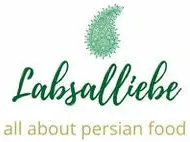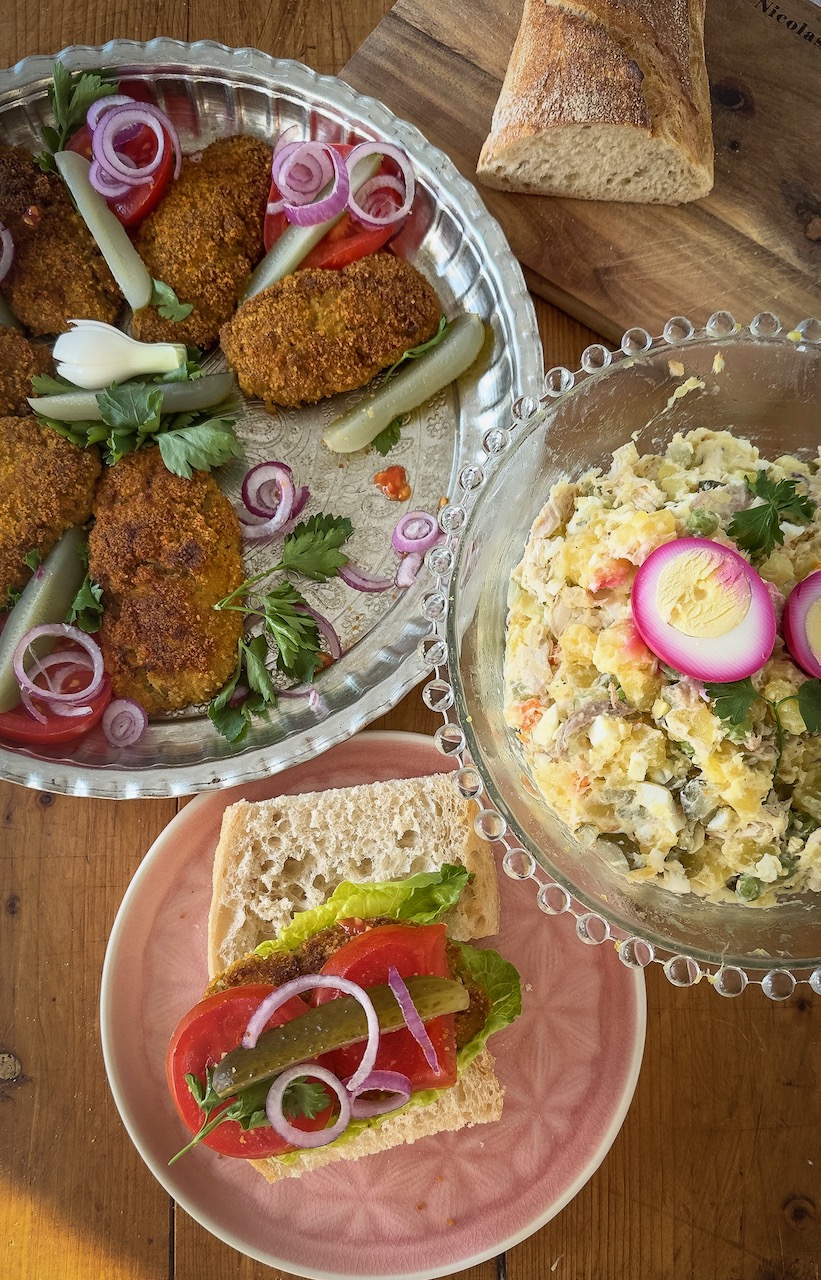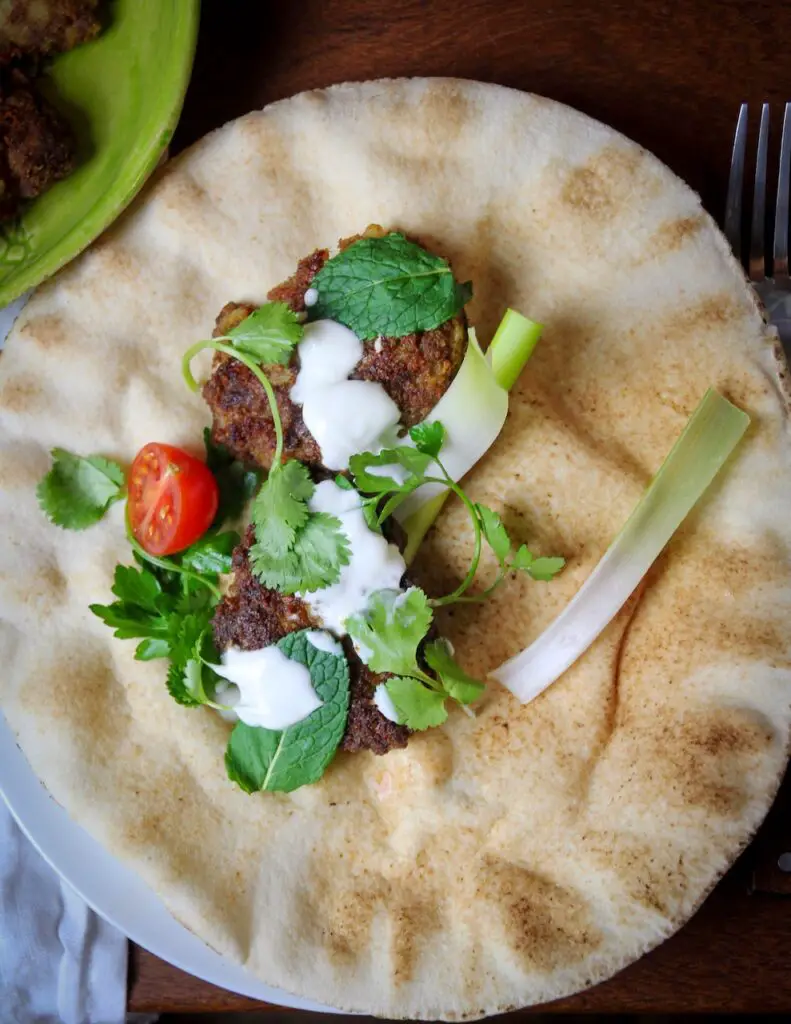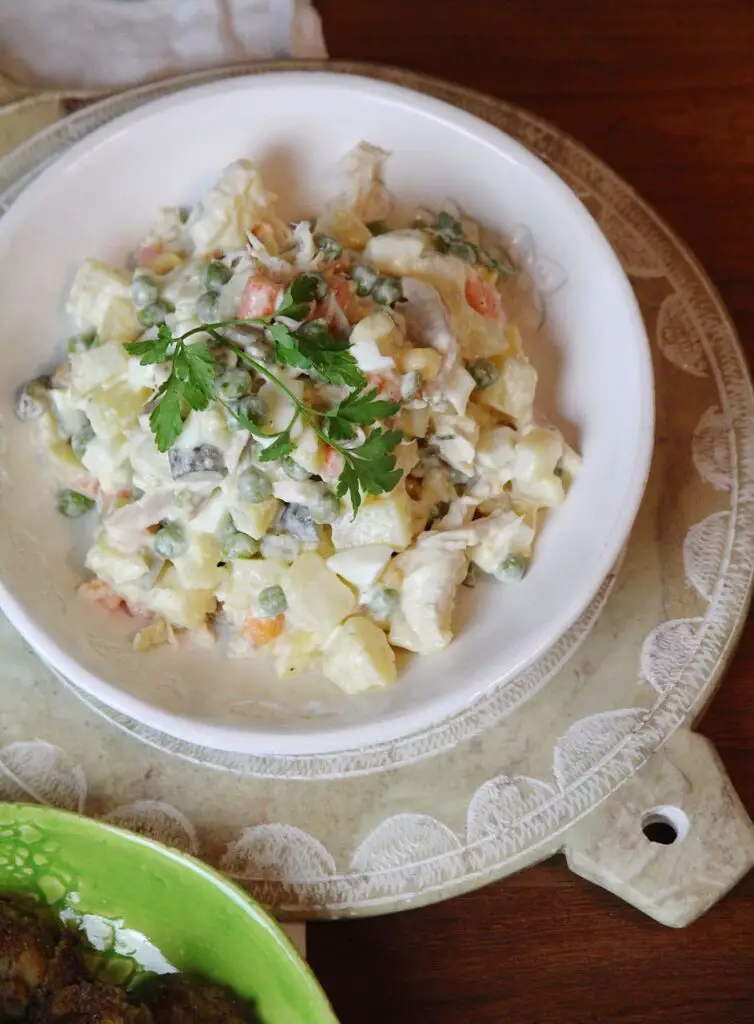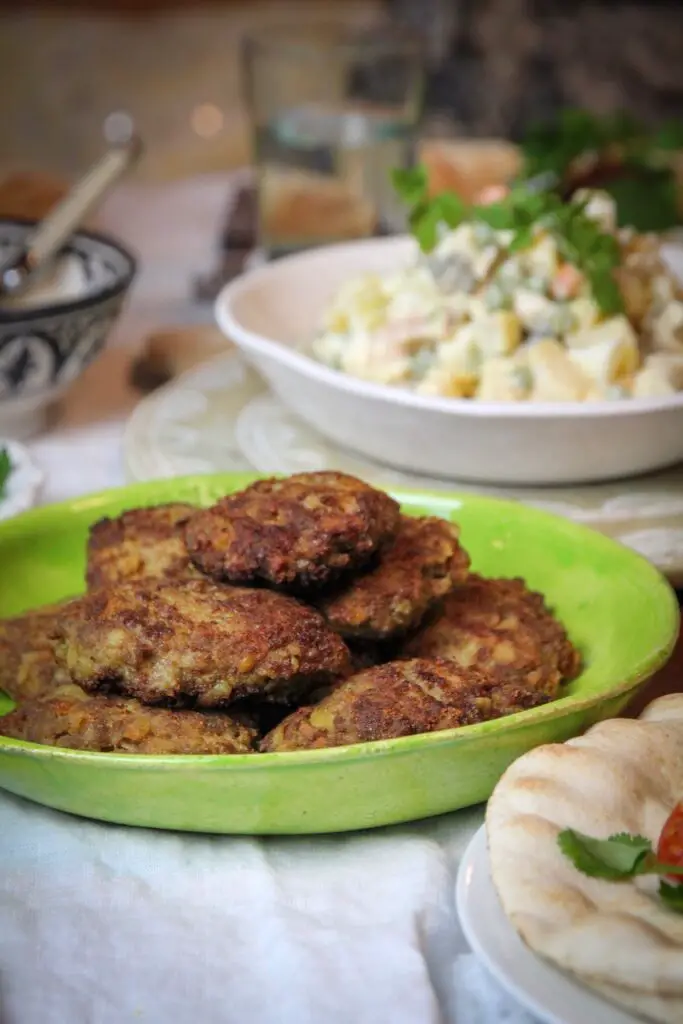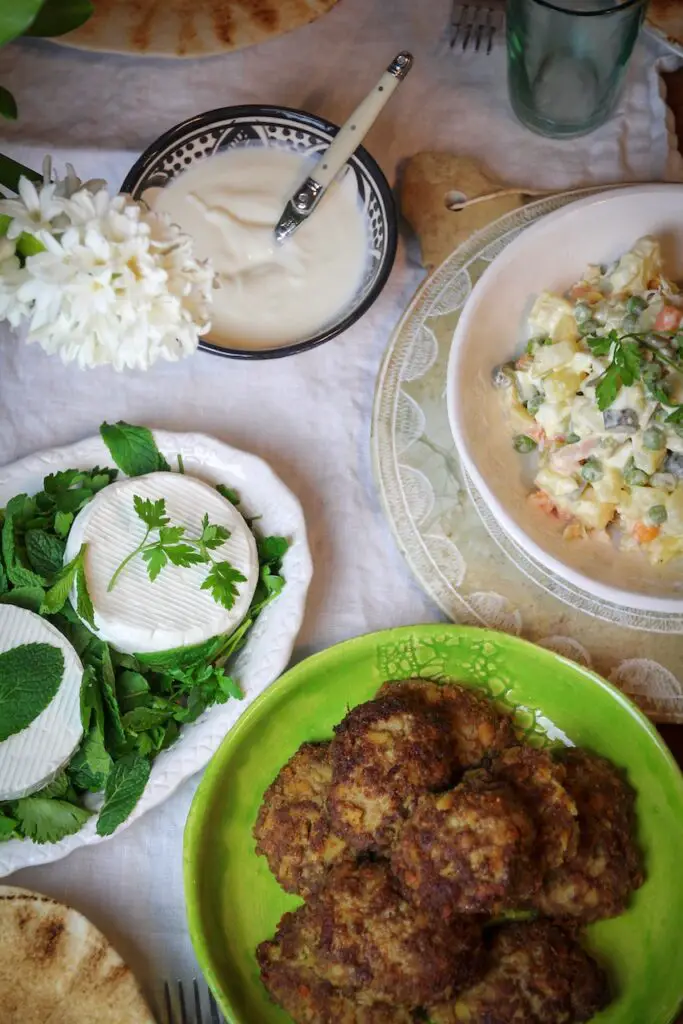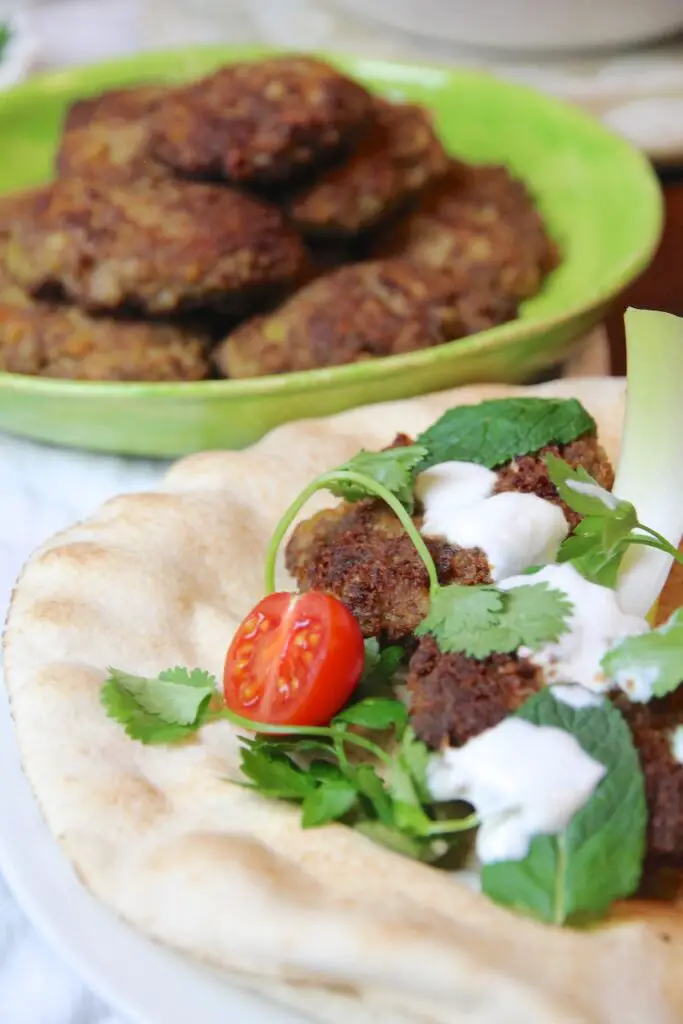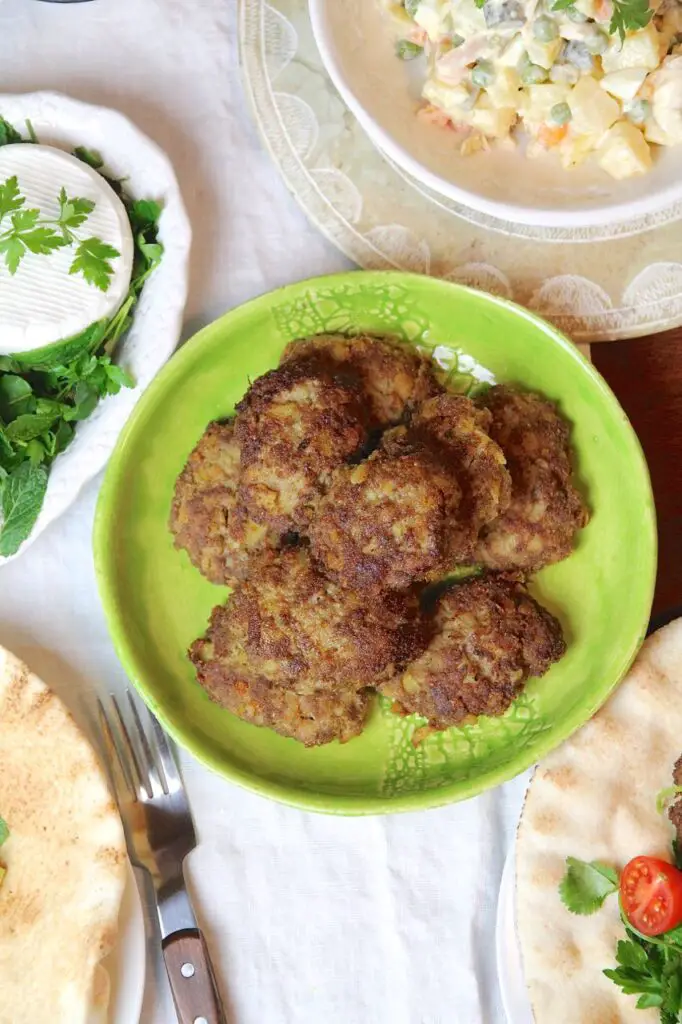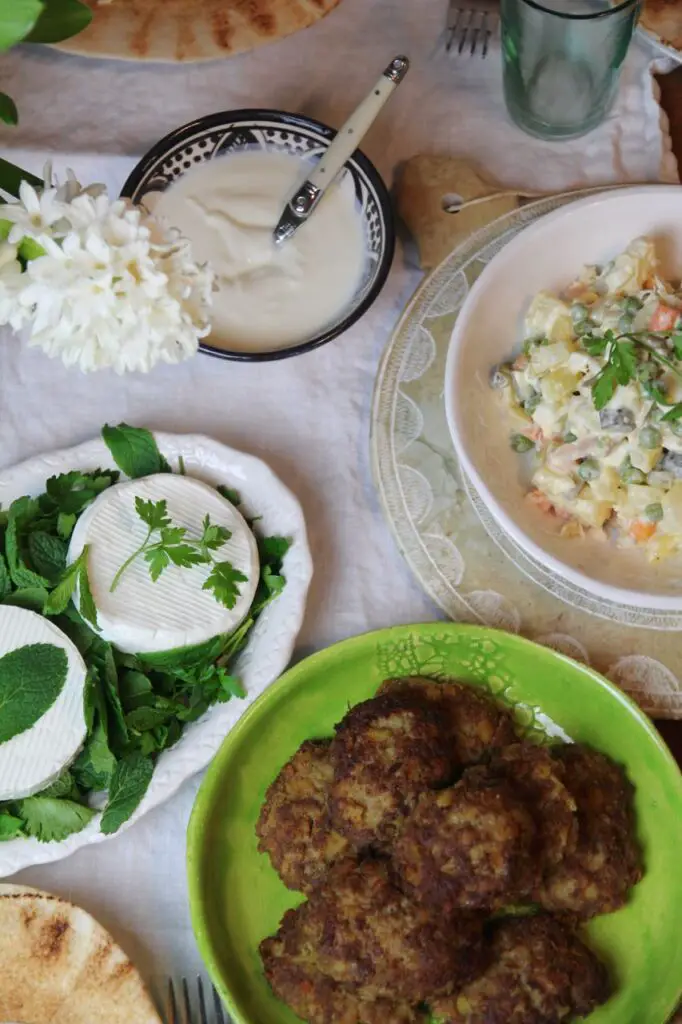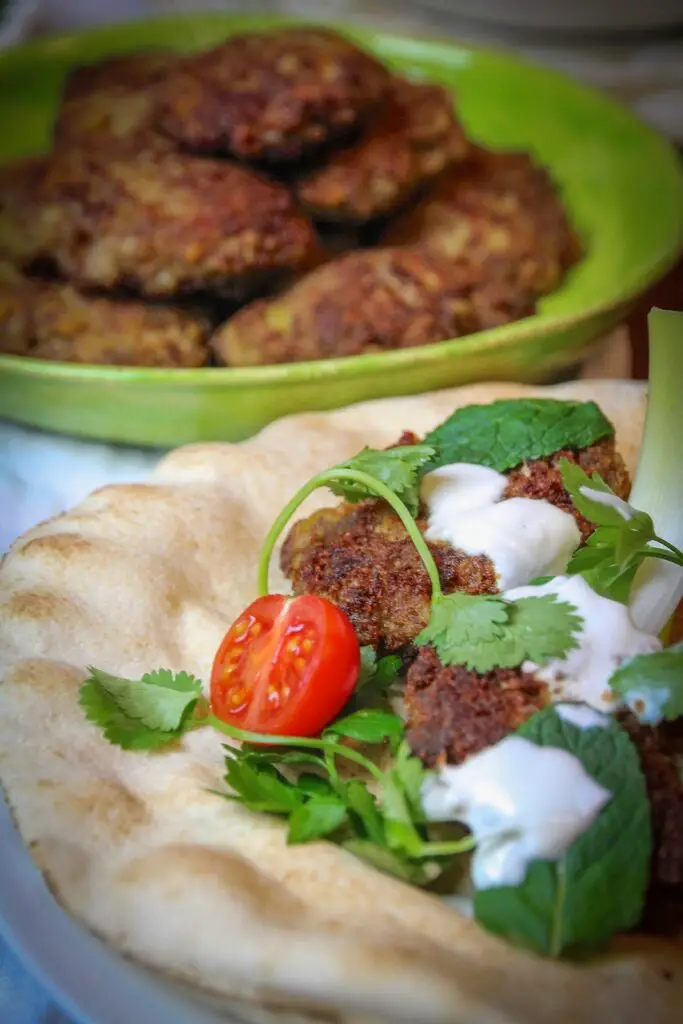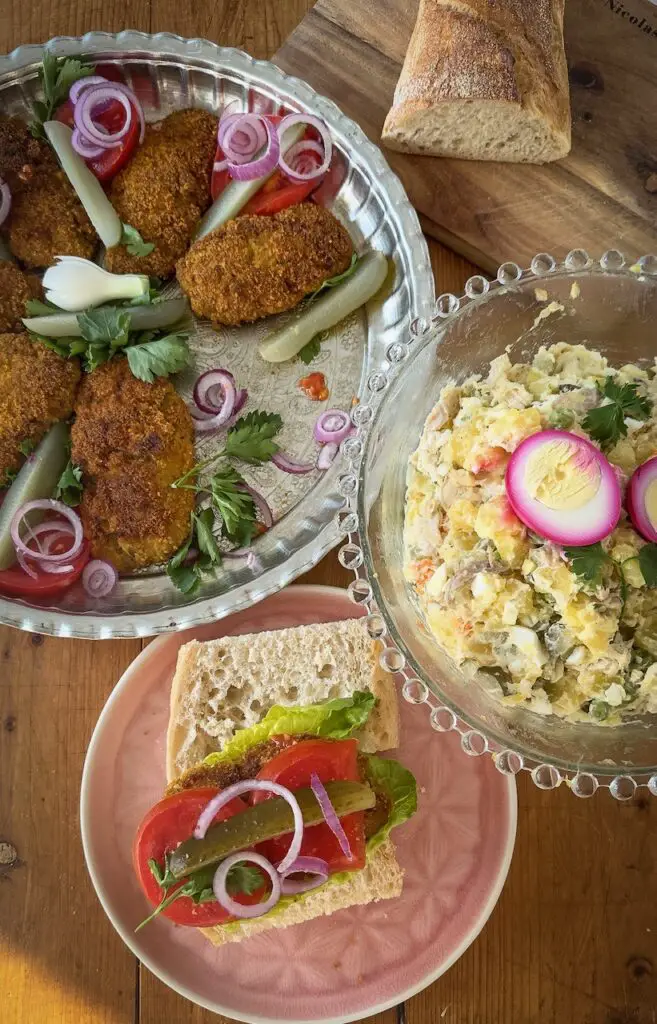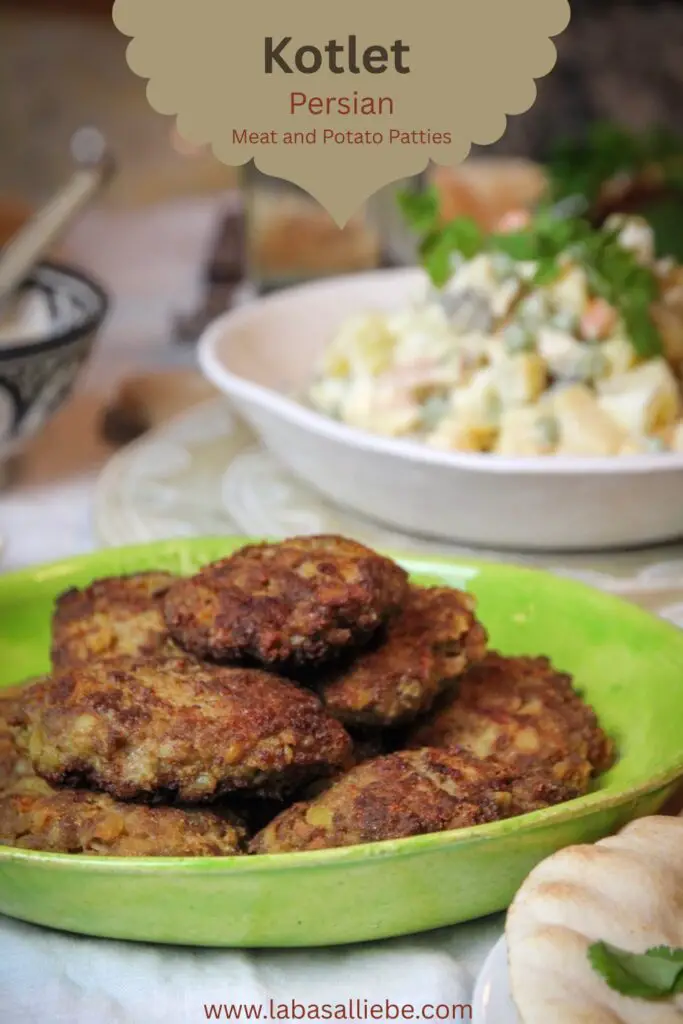Let me introduce you to one of the most loved comfort foods from Persian kitchens: Kotlet – Persian Meat and Potato Patties, or as some say, Kotelett. These are delicious, golden-brown patties made from a simple but flavorful mix of ground meat, potatoes, onions, eggs, and spices.
They’re wonderfully aromatic, with a perfect contrast in texture – crispy on the outside, juicy on the inside. Kotlets are quick to make and taste just as good cold as they do warm, which makes them perfect for everything from quick dinners to picnics or even lunchboxes.
In our family, we love to enjoy them in different ways. Sometimes we serve them as a main dish, other times as a side to Salad-e Olivieh – a creamy Persian chicken and potato salad.
But my absolute favorite? Wrapped in soft Lavash bread or tucked into a crusty baguette with a few simple toppings: fresh herbs, crunchy onions or scallions, juicy tomatoes, salty pickles, and a spoonful of creamy yogurt. It’s a flavor-packed sandwich that brings back so many childhood memories.
Kotlet isn’t just a dish – it’s a bite of home.
Watch my preparation video on Instagram
KOTLET – PERSIAN MEAT AND POTATO PATTIES
Savory, crispy, and incredibly versatile – this is Kotlet – Persian Meat and Potato Patties a true classic of Persian home cooking. These meat patties are perfect for picnics, buffets, or as a quick and filling meal any time of day. Served hot, they’re absolutely delicious. But they’re just as tasty cold, which makes them perfect for prepping ahead or packing for lunch.
I personally love frying them in ghee. It gives them a subtle, rich flavor and makes them easier to digest. Plus, ghee gives them that beautiful golden crust we all love.
Like many traditional dishes, every Persian family has their own version of Kotelett. Some use ground lamb or chicken, while others mix raw, grated potatoes directly into the beef instead of pre-cooking them. The spice blends also vary from kitchen to kitchen – a touch of cumin, cinnamon, turmeric, or even a hint of saffron can completely change the flavor profile.
Here, I’m sharing my favorite way to make them – just how I like them best: crispy on the outside, juicy on the inside, and full of comforting flavor.
Whether wrapped in lavash bread with fresh herbs and pickles, or served with rice and salad, these Persian patties are always a crowd-pleaser.
KOTLET – THE PERFECT ROAD TRIP SNACK
There are certain smells that instantly transport you back in time. For me, it’s the scent of freshly fried Kotlet in ghee – savory, warm, a little crispy. The moment I smell it, I’m back on the backseat of our car, somewhere between Tehran and the Caspian Sea, winding through the Alborz Mountains. I was still a child, but those road trips are etched deep in my heart.
My mother was a true travel prep expert. For every seaside getaway, she would lovingly prepare Salad Olivieh and Kotlet sandwiches – juicy meat patties made with ground beef and potatoes, seasoned with turmeric and just a hint of cinnamon, all tucked inside soft lavash bread.
And of course, she never forgot the big, bright yellow plastic jug filled with homemade lemonade. I can still picture it – the tiny spout always dripping, the lemonade perfectly chilled, tangy but not too sweet. To us kids, it was the best drink in the world. Those flavors, that smell, and the hum of the car as we climbed through the mountains toward the sea – it all comes back in an instant whenever I make Kotlet today.
THE CASPIAN SEA OR HOW WE CALL “SHOMAL”
The journey to the sea was never short, but it was always full of little adventures. Many people from Tehran have holiday homes or villas in the north, and so did we. We often stayed with relatives who lived near the coast, and every trip felt like a special occasion. The Caspian Sea, by the way, is the largest saltwater lake in the world. It’s nestled between Russia to the north, Turkmenistan to the east, Azerbaijan to the west, and to the south lies Iran.
Summers in Tehran were brutally hot, the air thick with smog that seemed almost solid. So, as soon as families had the chance, they would escape north – seeking the cooler breeze and greener landscapes of Shomal, as we lovingly call the region near the Caspian. Within just a few hours, the scenery would shift dramatically: from urban haze to lush hills, winding roads, and narrow switchbacks cutting through the Alborz Mountains. It was like watching the world transform right outside the car window.
I still remember how people used to talk about the Shah’s grand vision: a tunnel through the mountains. It would take you to the sea in just one hour. The adults were so excited by the idea – I can still hear the enthusiasm in their voices. But after the revolution, the dream was abandoned. So instead, we took the long way – climbing the steep mountain roads and then descending toward the sea.
Our car was always packed to the brim: with homemade food, swim gear, and a whole lot of excitement. Those trips to the Caspian weren’t just about the destination – they were about the journey, the anticipation, the joy of leaving the city behind and heading toward something that felt like freedom.
A SPECTACULAR JOURNEY – FROM TEHRAN TO CHALOUS
It was my father’s favorite route – the drive from Tehran to Chalous via Karaj, one of the oldest and most beautiful roads in the world. Every time we headed to the Caspian Sea, he insisted on taking this path. For him, the journey wasn’t just about getting somewhere – it was part of the experience, a ritual, a road full of breathtaking views and hidden stories.
The real adventure began in Karaj, on the outskirts of Tehran. This area is home to several reservoirs that provide both drinking water and electricity to the millions living in the capital. But as soon as you leave the last signs of the city behind, the landscape begins to shift – and the magic begins.
The dry, barren plains slowly give way to massive mountain ranges. These rugged chains seem to twist and stretch endlessly toward the sky, like a stone ribbon unraveling into the clouds. And the views? Absolutely spectacular. At every turn, the road opens up to deep valleys, steep cliffs, and in the distance, the snow-capped peaks of the Alborz Mountains. It’s the kind of scenery that makes you pause, even in a moving car.
This road wasn’t just a route to the sea. It was a passage through some of Iran’s most dramatic landscapes, and for us, a passage into holiday joy and childhood memories.
THE CASPIAN FOREST
The road winds its way through the Alborz Mountains, a natural wonder full of striking contrasts. At first, the vegetation is sparse, almost desert-like. But as you climb higher toward the Kandovan Pass – the highest point on the route – the surroundings begin to transform. The higher we got, the thicker the forest became. Mist clung to the trees, and now and then a cow or a donkey would wander across the road. On the roadside, local vendors sold fresh fruit, pickled garlic cloves, or steaming hot corn on the cob. Everything smelled of earth, rain, and forest.
And then – almost without warning – something magical happens. The landscape tips, quite literally, but in the best possible way. The road begins to descend, the climate turns milder, the air becomes humid and rich, and suddenly the forest bursts into deep, vibrant green. This is where the wild, romantic part of the journey begins.
You’re now entering a forest so dense, it feels like a jungle. These are the tallest and oldest beech forests in the world, a natural treasure that still remains untouched. It’s hard to believe, but even today, bears, lynxes, and wolves still live deep in these woods. There’s something mysterious and almost sacred about it – a rare piece of nature that feels truly alive. This is the Caspian Forest, the last great temperate deciduous forest on Earth. And you drive right through the heart of it.
The road is narrow, winding, and steep – often dangerously beautiful. Tight switchbacks hug the mountainside, and towering rock faces lean out over the edge of the road. From many of these rocks, tiny waterfalls spill down, glistening in the sun. On especially hot days, we would stop the car, get out, and stand under the cold mountain water. It was our very own kind of refreshment – better than any air conditioning.
MOUNTAIN STREAMS, ROCK GORGES, AND ROADSIDE TEAHOUSES
Along the way, wild mountain streams rushed beside us, tumbling over rocks and weaving through narrow gorges carved deep into the stone. Every so often, we’d pass a small teahouse or roadside inn – simple wooden huts with rickety tables set right by the water. We’d stop for a break, sip hot black tea with fresh mint, and let the sound of the rushing water calm us. Everything felt slower here, more peaceful – as if time itself had paused, just for a moment.
And then – after all the bends, the steep climbs, and the little stops – it happened. The forest would begin to thin out, and suddenly, there it was: A shimmer on the horizon. The Caspian Sea.
That first glimmer of blue was pure magic. As a child, it gave me butterflies every time. “There it is!” we’d all shout in unison, our eyes wide with excitement. The joy, the relief, the tingling anticipation – it’s a feeling I’ve never forgotten. This journey was so much more than a drive. It was a transformation, a passage between two worlds: From the hot, dusty chaos of Tehran into a lush, green, almost fairy-tale realm. And at the end – the sea. That endless, sparkling sea.
Do you have a route like that? A road you’ll never forget, one that fills you with wonder every time you take it? I’d love to hear your story.
DELICACIES FROM THE CASPIAN SEA
As soon as we arrived at the Caspian Sea, my father knew exactly what had to happen first: Pull over – and buy Koloocheh! These soft, round pastries with their gentle cardamom aroma were his absolute favorite. Filled with sweet dates, coconut, or chopped walnuts, they tasted best fresh from the bakery, still warm to the touch.
To me, they’ve always been the true flavor of vacation.
My parents loved stopping at small roadside stalls along the way – a habit I’ve definitely inherited. Even here in Germany, I can’t resist pulling over when I see a little farm stand. Back then, we’d buy fresh eggs, local honey, pickled garlic cloves (Sir Torshi), and whatever else the season had to offer. Everything was homemade, seasonal, and filled with care – a world away from the supermarket shelves in the city.
FISH, CAVIAR, RICE AND TEA FROM THE CASPIAN SEA
One of the region’s true delicacies is the sturgeon, the source of the world-famous caviar. Naturally, you’ll find countless seafood restaurants along the coast, each one offering fresh fish in all its glory – grilled, braised, or stuffed with fragrant herbs and tangy barberries. My personal favorite? Freshly caught fish, grilled over charcoal, served simply with a generous scoop of aromatic dill rice. Nothing fancy – just pure, honest flavor that tastes like the sea and summer.
The humid, subtropical climate of the Caspian region isn’t just perfect for relaxing – it also provides ideal conditions for rice and tea cultivation. Especially around Lahijan, you’ll see lush green rice paddies and tea plantations stretching across the hillsides like a soft, living carpet. If you ever visit, take your time.The view alone is worth the trip – like stepping into a painting, with layers of misty mountains and rows of tea bushes glowing in the afternoon sun.
THE SCENT OF ORANGE BLOSSOMS IN THE AIR
In springtime, a very special scent fills the air: orange blossoms. Delicate and fleeting, their fragrance is carried on the warm breeze – soft, floral, slightly citrusy. The blossoms are picked by hand and turned into all sorts of delicacies: orange blossom water, jam, and syrup. I especially love them in tea – often paired with bergamot – giving the cup an elegant, almost dreamy aroma. It’s soothing and uplifting all at once, like a warm memory.
By the way, on my blog you’ll find a recipe for cardamom yeast rolls with orange blossom water – a little touch of fusion kitchen, wrapped in the nostalgic flavors of the Caspian Sea.
FLAVORS FROM THE CASPIAN REGION
On my blog, you’ll find plenty of delicious recipes inspired by the Caspian Sea region. Here are some of my favorites.
Kaka Kadu – savory Persian pumpkin pancakes
Baghali Ghatogh – fava beans with dill and eggs
Nargesi – sautéed baby spinach with fried eggs
Mirza Ghasemi – smoky eggplant dip with eggs
Khoresht-e Porteghal– Orange Chicken Legs خورش پرتقال
Fesenjan – lamb slow-cooked in a sweet and sour pomegranate-walnut sauce
Vavishka – a quick and tasty skillet dish
Torsh-e Tareh – vegetarian herb stew with eggs
Nan-e Keshta – pumpkin flatbread cooked in a pan
Khoresht-e Kadu Halvai – pumpkin and chicken stew خورش کدو حلوایی
Reshteh Khoshkar – gluten-free sweet dumplings رشته خوشکار
Ash-e Anar ba Koofteh Ghelgheli – thick pomegranate soup with meatballs and mint oil آش انار
Zeytoon Parvardeh – Persian-style marinated olives
Morgh-e Shekam Por – Persian stuffed roast chicken
THE CLIMATE AT THE CASPIAN SEA
Sometimes it takes just a certain scent, a ray of sunshine, or the sight of a fig tree — and suddenly, you’re back. Back in a moment, a memory, a place that means so much to you. For me, that place is the Caspian Sea.
The climate there is subtropical — warm and humid — and the nature reflects that abundance. Palm trees, orange, lemon, and fig trees grow naturally along the roadsides, much like in Mallorca, where I love to spend my time now. Maybe that’s why I felt so at home in Mallorca so quickly: it reminds me of my childhood by the Caspian Sea, of long summers and the happiest days I ever had in Persia.
We almost always spent our holidays with friends or the big family — laughing, cooking, swimming, and sharing stories. The sea wasn’t just a place to swim; it was full of life and freedom. I remember clearly how we jumped into the high waves, shouting with joy, without fear — as kids, we wanted just one thing: to go a little deeper, a little further out.
The sand was as fine as powdered sugar, and often we walked far into the shallow water where little lagoons formed between the sandbanks — perfect little worlds for splashing and swimming. It was pure happiness. No worries, no clock — just sun on our skin, saltwater on our lips, and the sound of waves in our ears. When I think of the Caspian Sea today, I don’t just see the blue water or the green forests around it — I feel something deeper: a loving memory of a home in nature, a carefree joy you only know as a child.
INGREDIENTS FOR KOTLET
Makes about 12 kotlets
4 large potatoes (boiled with skin)
1 onion
500 g ground beef
1 egg
each 1 tsp turmeric*
and 1 tsp cinnamon*
Salt and pepper to taste
100 g breadcrumbs*
2 tbsp ghee* (clarified butter)
PREPARATION KOTLET
Boil the potatoes with their skin until soft. Let them cool down completely, then grate them.
Grate the onion and squeeze out the extra juice (so the mix doesn’t get too wet).
In a large bowl, mix the ground meat, egg, and spices (turmeric, cinnamon, salt, and pepper). Add the grated potatoes and onion to the meat mixture. Mix everything very well with your hands until smooth.
Put breadcrumbs on a plate.
Take a small amount of the mixture and shape it into an oval, flat patty (like a thin burger).
Press both sides of the patty gently into the breadcrumbs. Place the kotlets on a tray lined with baking paper.
Heat some ghee (or oil) in a pan. Fry the kotlets until they are crispy and golden on both sides. Place them on kitchen paper to remove extra oil.
Befarmayid
Susan
The beautiful handmade plates are by Pottery Twins. The items marked with * are affiliate links, referral links. If you buy through this link, I get a small commission. The price stays the same for you and you can easily support my efforts. A big thank you ♥
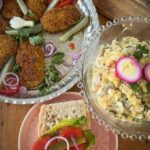
Kotlet – Persian Meat and Potato Patties
Crispy on the outside, juicy on the inside
Ingredients
INGREDIENTS FOR KOTLET
- 4 large potatoes boiled with skin
- 1 onion
- 500 g ground beef
- 1 egg
- 1 tsp turmeric
- 1 tsp cinnamon
- Salt and pepper to taste
- 100 g breadcrumbs
- 2 tbsp ghee clarified butter
Instructions
PREPARATION KOTLET
-
Boil the potatoes with their skin until soft.
-
Let them cool down completely, then grate them.
-
Grate the onion and squeeze out the extra juice (so the mix doesn’t get too wet).
-
In a large bowl, mix the ground meat, egg, and spices (turmeric, cinnamon, salt, and pepper).
-
Add the grated potatoes and onion to the meat mixture. Mix everything very well with your hands until smooth.
-
Put breadcrumbs on a plate.
-
Take a small amount of the mixture and shape it into an oval, flat patty (like a thin burger).
-
Press both sides of the patty gently into the breadcrumbs. Place the kotlets on a tray lined with baking paper.
-
Heat some ghee (or oil) in a pan. Fry the kotlets until they are crispy and golden on both sides.
-
Place them on kitchen paper to remove extra oil.
Recipe Notes
Serve as a Wrap, or a Sandwich with Salad Olivieh.
Save the recipe for later on Pinterest!
Have you cooked this or maybe another delicious recipe of mine? Feel free to leave me a comment below. If you tag your picture on Instagram with @labsalliebe and use the hashtag #labsalliebe, I won’t miss a post and will be happy to leave you a comment as well. Can’t wait to see your creations.
♥♥♥♥♥♥♥♥♥♥♥♥♥♥♥♥♥♥♥♥♥♥♥♥♥♥♥♥♥♥♥♥
This website is created by me in my leisure under proper use of coffee 🙂 If you like my posts I would be happy if you donate me one or a few cups of coffee!
♥♥♥♥♥♥♥♥♥♥♥♥♥♥♥♥♥♥♥♥♥♥♥♥♥♥♥♥♥♥♥♥
Donate an amount of your choice via Paypal.
